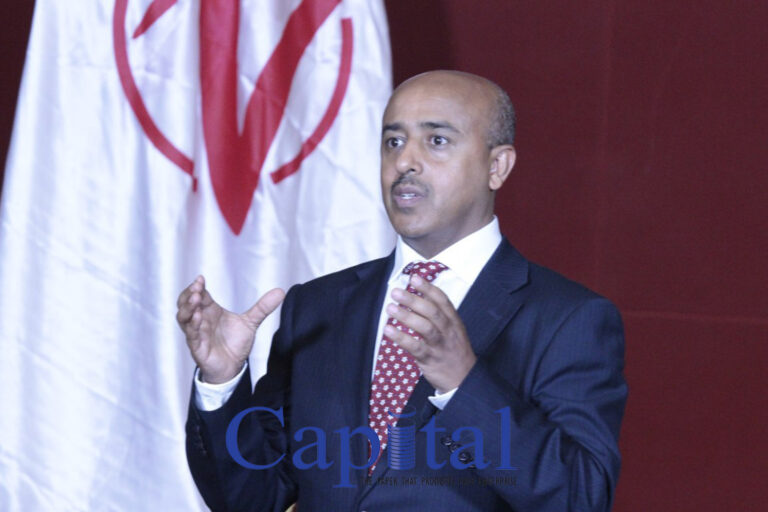The Grand Ethiopian Renaissance Dam (GERD) hydraulic steel structure and electromechanical works is said to have registered massive progress.
Sileshi Bekele (PhD), Minister of Water, Irrigation and Energy, announced that the hydraulic steel structure work is now at 20.4 percent from 13.88 percent, while the electromechanical part of the project reached 44.3 percent from 25.6 percent.
Both parts of works of the project have been delayed in the past and some of the works are rearranged after Metal and Engineering Corporation (MetEC) left the project.
According to Sileshi, the project is accelerating to be able to fill the dam according to the plan in the coming rainy season. He said that the civil work at the site that is located near the border of Sudan has reached 86.6 percent from 80 percent.
“The concrete filling work that was suspended for five years due to the delay of electromechanical part of the project has started this month,” he added.
The concrete filling that will be carried out in the coming 100 days will allow the country to start caching water in the coming rainy season.
So far the project that celebrates its 9th year starting anniversary on Thursday April 2 without public event due to the corona virus pandemic is now at 72.4 percent.
The government has assigned several well known global companies to engage on the project besides supplying equipment.
It said that the project would not have significant harm on the riparian countries.
The downstream countries, Sudan and Egypt besides Ethiopia are negotiating on the project meanwhile final agreement is not reached.
Ethiopia criticized Egypt that it makes the negotiation political than focusing on technical issues than solving differences in a professional manner.
Recently the three countries started negotiation by involving US and the World Bank as observer but US attempted to directly involve in the negotiation which Ethiopia refutes.
In relation with the 9th anniversary of GERD Prime Minister Abiy Ahmed called the general public to continue to support the project by buying the bond lottery for the project. He recalled that the project civil work will be finalized in the coming rainy season.
Ethiopia in full force to complete GERD
Zemen relieves loan interest for flower exporters
Zemen Bank responded to the questions raised by the floriculture industry by suspending loan interests, which is highly affected by the COVID 19 pandemic outbreak.
Dereje Zebene, president of Zemen, announced that his bank has decided to suspend the loan interest for flower exporters for three months until June 30, which is the last date of the financial year.
He said that the bank is also ready to apply other potential support for the fragile business, which is highly affected due to the major market destinations in Europe closed their doors fearing the pandemic.
“We will also provide a working capital if it is necessary,” Dereje said in a press briefing held on Friday April 3, 2020 at Intercontinental Hotel.
A week ago Prime Minister Abiy Ahmed stated that to encourage banks to consider suspension of loan interest and provide additional facility the government has allocated 15 billion birr from National Bank of Ethiopia, to banks.
Dereje said that besides the horticulture sector other businesses will also get similar support.
“The incomparable difference of the flower sector is it should have run the farms meanwhile it could not export products due to that their operation is severely affected. They are also handling more than 150,000 labour,” the bank president elaborated why the horticulture sector got prior attention.
“We have more than half a billion birr loan portfolio that will give clear picture how much loss we will incur when we suspend the interest rate for the horticulture sector but we don’t want to disclose the amount because it is a solidarity gesture than promotion of the bank,” Dereje told Capital.
He said that the resource of the bank is the public and that resource should support the public on such kind of situations.
Rescheduling loan settlement is also included in the latest decision of the bank, according to the president.
Zemen has also given five million birr to combat the pandemic. “The gift is from everyone to everyone,” the bank said.
The bank has also annulled 75 percent of the extension commission fee in the course of extending the validity of bank services for customers, while the balance is provided for health workers, who fight the virus.
“So far 800,000 birr has been secured from 25 percent commission that will be given for Ministry of Health to use on keeping the safety of health workers who are at the front of the pandemic battle,” Dereje said. He said that providing the earning from the commission will continue until the problem is fully tackled.
The bank has also commenced an initiative to mobilize money from its employees to provide further support.
Currently Zemen provide unlimited transaction via internet banking and allow withdrawing 12,000 birr from ATM.
The bank encourages clients to use such kind of services since it is helpful to keep the physical distancing because of the outbreak.
Industries Hit Hardest by the Coronavirus Pandemic
Almost every country in the world now has at least a few people infected with SARS-CoV-2. The novel coronavirus that emerged late last year in China has taken the world by storm, becoming a nightmare for many countries’ health systems, pushing the world into a crisis, and pushing nearly 3.5 billion people into self-imposed or mandatory confinement.
The long-term effects of the pandemic are still unknown at this point. There are, in turn, several industries that feel the full effect of the crisis.
Entertainment, Hospitality, and Sports
The global entertainment industry was among the first hit hard by the pandemic. Governments all over the world have limited the number of people allowed to gather – in some places, to three, in others, to two – and ordering the closure of venues where people gather and spend a relatively long time.
“As a result, sporting events, movie screenings, conventions, and similar gatherings are out of the question. Restaurants, bars, even the casinos were affected by the coronavirus pandemic – in some countries – all of the had to close. Luckily, home delivery is still working, and those with a passion for gaming can always explore the world of progressive jackpots and tons of games online. In the areas hit hardest by the disease, some of the already empty hotels are used by the authorities as makeshift hospitals to treat the milder cases of infection, thus freeing up hospital beds for those in a more serious condition.”
Concerts, conventions, festivals, and movie premieres are postponed and cancelled. Sports are pretty much off the table in the northern hemisphere, even the Summer Olympics were postponed for 2021. And things are not expected to return to normal for at least a year.
Airlines and airports
The restrictions imposed by the health authorities on travel are a major blow to airlines all over the world. The global airline industry will lose hundreds of billions this year. In an estimate issued in mid-March, International Air Transport Association economist Brian Pearce pointed out that up to 75% of all airlines have reserves to last them up to three months – and if their revenues don’t return to normal (or they don’t receive a massive infusion of cash from other sources, like governments), many of them can go bankrupt.
Airports are in a similar situation – they, too, have fixed costs and no revenues to cover them.
Oil
With people on lockdown, with planes grounded due to a massive lack of demand, oil consumption has reached a new low – and so did the price of oil. To make things worse, the production cut requirements of OPEC+ countries have expired on April 1st, and at least some of them have announced that they plan to ramp up production starting this date.
These factors have led to a massive drop in the price of crude oil to a point unseen since 2002. Analysts expect the drops to continue as the global crude storage capacity reaching its limits by the second quarter of this year – some say oil prices may even test the $10 per barrel level.
… and many others
The demand for entire categories of products is at a minimum due to the ongoing pandemic. Car manufacturers are reporting a drop in demand – France, for example, has reported a 72% year-on-year drop in new car registrations in March. Transport companies are also feeling the decrease in demand, reporting two-digit decreases across the board. And decreases have been reported in every sector from movie production to construction.
Task force set up to decide the future of academic year
The global pandemic COVID-19 is becoming another additional headache to the education system which was already crippled by violence in the past few months.
The Ministry of Education is contemplating to postpone the National University Entrance Exam of grade 12 which was scheduled to be conducted from June 1 up to June 3.
“The Ministry has formed a task force to oversee the situation and if things get worse there is a possibility that the date will be changed” said Haregua Mamo, communication director of the Ministry of Education.
However sources told Capital the printing of exam materials, which is done at Berhanena Selam Printing Enterprise is put on hold for the last two weeks.
On Monday, March 16, 2020 three days after the first case of corona virus was announced, the prime minister ordered to close schools across the country and for university students to remain where they are deterring mobility for two weeks for fear of the virus.
And on March 27, 2020 the government decides to extend the closure for two more weeks and students from higher educations to go back to their home.
The Ministry of Science and Higher Education that is responsible for Universities across the country announced that it is considering making instructional materials available online for students.
More than 20 million students over the country are obliged to stay at home as a result of the announcement.
Dechasa Gurme, Communication director of Ministry of Science and Higher Education said “if things get back to normal and if the government announces that students can go back to their schools in the coming one month, students may go to their university but if this cannot happen, students may be obliged to start their education in the coming year.”
In the past two to three years most higher education facilities were facing instabilities due to the political situation of the country.
A report by the ministry shows that in the past six months more than half of the 45 universities in two regions and Dire Dawa were knocked down by instability, and more than 35,000 students’ quit their classes because of the security issues.
Currently most of the higher education institutions are preparing to serve as a quarantine if things get worse in the country.
Different countries in the world are announcing that their schools will remain closed for the rest of the academic year due to the coronavirus pandemic.






